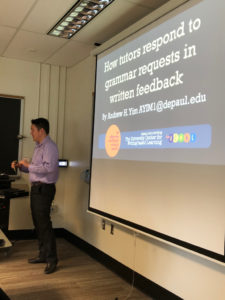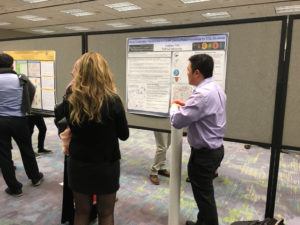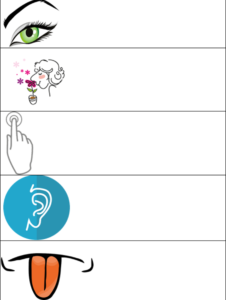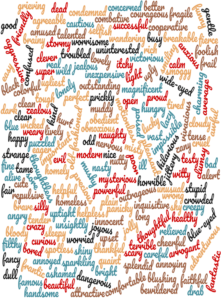In my 3rd quarter as a Graduate Assistant here at the DePaul University Center for Writing-based Learning (UCWbL), I had the opportunity to present at two conferences that furthered my interests in multilingual writing and research. The first conference, the East Central Writers Association Conference (ECWCA), took place in Columbus, Ohio between March 23rd and 25th, 2018. The second conference, the TESOL Convention, took place in Chicago, Illinois between March 27th and 30th, 2018.
ECWCA Conference
At the ECWCA conference, I presented research about the best tutoring practices at the DePaul UCWbL. I analyzed what types of grammar feedback native English speakers and English Language Learners request in their written feedback appointments and how tutors respond to these requests. My methodology involved collecting request forms from both native speakers of English and English Language Learners. I also collected summary letters from tutors who responded to these writers. The UCWbL research team collected information about different written feedback appointments conducted between September 11 to October 11, 2017. They organized this information in an Excell spreadsheet, which I then randomly chose participants from. I created word clouds to determine the textual relationships between the request forms and summary letters. I found that writing-center administrators and tutors may find it beneficial to evaluate the role of grammar support in writing center tutorials in their own writing centers.
Figure 1. Me at the ECWCA Conference
TESOL Conference
At the TESOL Conference, I presented a poster titled “Using Visualization Techniques to create Literacy Autobiographies for ESL Students.” In this poster presentation, I identified the use of literacy autobiographies as personal, reflective essays where writers outline their literary practices, how they came to use those practices, and how these practices have shaped their overall understanding and perspective of reading and writing. I explained three visualization strategies that teachers can incorporate into this assignment: mind mapping, five senses, and word clouds.
Figure 2. Me at the TESOL Conference
Prewriting Your Literacy Autobiography with Mind Mapping
Mind maps include pictures, words, and quotes that make up a diagram that visually organizes information in prewriting. ESL writers can use both their prior and new knowledge to create their mind maps. Below is a lesson plan for teachers interested in incorporating mind mapping as a prewriting strategy when writing a literacy autobiography assignment.
- Assign the literacy autobiography to the students and explain what the assignment is.
- Break up the class into pairs.
- Once pairs have been decided, have each pair create their own mind maps.
- After they have created their own mind maps, the pair will compare their mind maps.
- They will then have to create an outline based on their mind map.
Figure 3. Example of a Mind Map.
Composing your Literacy Autobiography Using the Five Senses
The five senses table helps writers visualize ideas through using the five senses: smell, touch, sight, taste, and hearing. This strategy can be used as a drafting technique. Writers writing personal statements, literacy autobiographies, and creative writing assignments can benefit from using a five senses table to generate new ideas.
- Introduce the five senses table to the class.
- The teacher will split the students into pairs.
- Give students some time to free write about experiences inspired by their literacy autobiography.
- Pairs will share their tables with each other.
- Students will begin composing their first draft based on their tables.
Figure 4: Five Senses Table
Revising Your Literacy Autobiography with Word Clouds
Word clouds allow students to analyze text by understanding the relationship between terms and visualizing the size of the word, as words that appear more frequently in the text show up bigger and words that appear less frequently show up smaller in the word cloud. Word Clouds can be used to identify keywords in texts that ESL students can reference and look up the definition to enhance their vocabulary skills. ESL writers can use word clouds to see if they use the certain words often in their writing, and they can use this information to begin thinking about how those words are functioning and if there are opportunities to widen their vocabulary.
- Students will take their first drafts of their literacy autobiography and use word clouds to help revise the assignment.
- After watching a video on how to make word clouds, the students will input the essay onto wordclouds.com and create a word cloud.
- Based on this word cloud, they are going to revise their literacy autobiography.
Figure 5: Word Clouds






